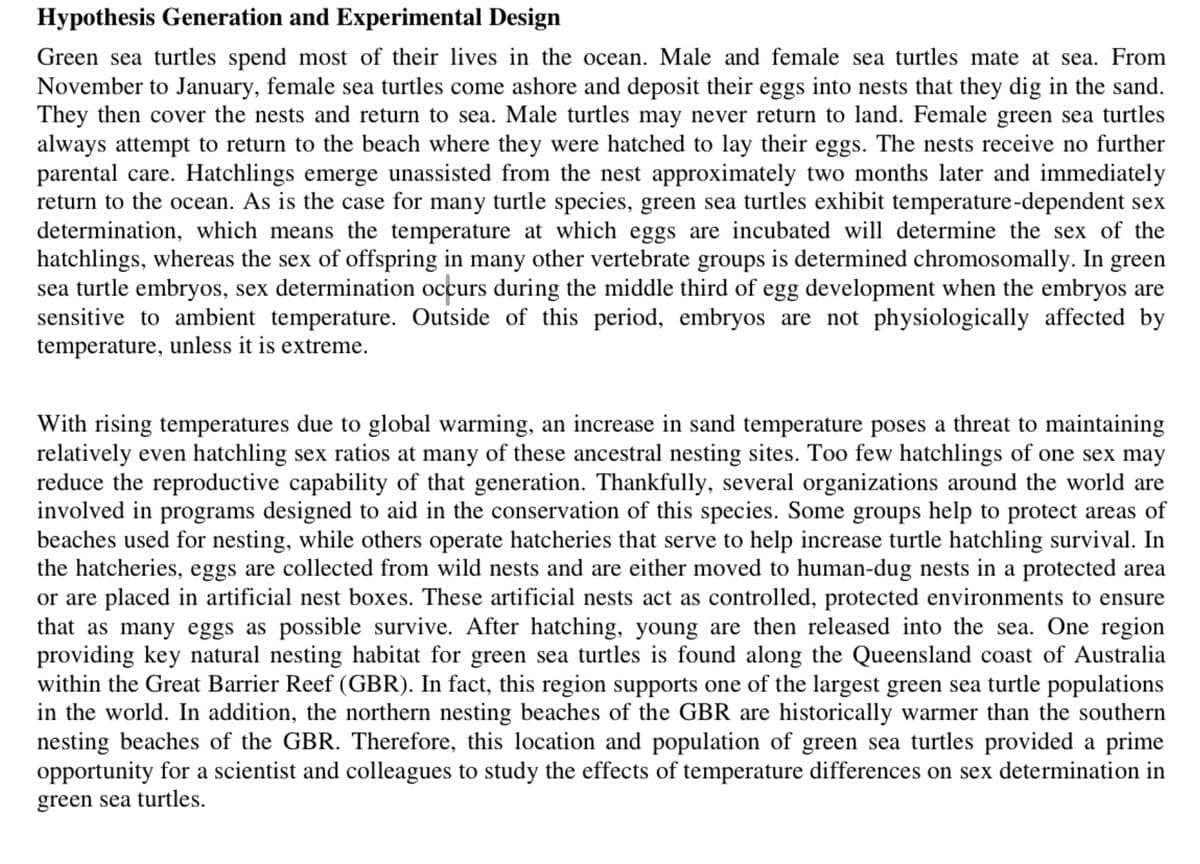Biology Today and Tomorrow without Physiology (MindTap Course List)
5th Edition
ISBN:9781305117396
Author:Cecie Starr, Christine Evers, Lisa Starr
Publisher:Cecie Starr, Christine Evers, Lisa Starr
Chapter15: Animal Evolution
Section: Chapter Questions
Problem 1DID
Related questions
Question
create a null hpothesis

Transcribed Image Text:Hypothesis Generation and Experimental Design
Green sea turtles spend most of their lives in the ocean. Male and female sea turtles mate at sea. From
November to January, female sea turtles come ashore and deposit their eggs into nests that they dig in the sand.
They then cover the nests and return to sea. Male turtles may never return to land. Female green sea turtles
always attempt to return to the beach where they were hatched to lay their eggs. The nests receive no further
parental care. Hatchlings emerge unassisted from the nest approximately two months later and immediately
return to the ocean. As is the case for many turtle species, green sea turtles exhibit temperature-dependent sex
determination, which means the temperature at which eggs are incubated will determine the sex of the
hatchlings, whereas the sex of offspring in many other vertebrate groups is determined chromosomally. In green
sea turtle embryos, sex determination occurs during the middle third of egg development when the embryos are
sensitive to ambient temperature. Outside of this period, embryos are not physiologically affected by
temperature, unless it is extreme.
With rising temperatures due to global warming, an increase in sand temperature poses a threat to maintaining
relatively even hatchling sex ratios at many of these ancestral nesting sites. Too few hatchlings of one sex may
reduce the reproductive capability of that generation. Thankfully, several organizations around the world are
involved in programs designed to aid in the conservation of this species. Some groups help to protect areas of
beaches used for nesting, while others operate hatcheries that serve to help increase turtle hatchling survival. In
the hatcheries, eggs are collected from wild nests and are either moved to human-dug nests in a protected area
or are placed in artificial nest boxes. These artificial nests act as controlled, protected environments to ensure
that as many eggs as possible survive. After hatching, young are then released into the sea. One region
providing key natural nesting habitat for green sea turtles is found along the Queensland coast of Australia
within the Great Barrier Reef (GBR). In fact, this region supports one of the largest green sea turtle populations
in the world. In addition, the northern nesting beaches of the GBR are historically warmer than the southern
nesting beaches of the GBR. Therefore, this location and population of green sea turtles provided a prime
opportunity for a scientist and colleagues to study the effects of temperature differences on sex determination in
green sea turtles.
Expert Solution
This question has been solved!
Explore an expertly crafted, step-by-step solution for a thorough understanding of key concepts.
Step by step
Solved in 2 steps

Knowledge Booster
Learn more about
Need a deep-dive on the concept behind this application? Look no further. Learn more about this topic, biology and related others by exploring similar questions and additional content below.Recommended textbooks for you

Biology Today and Tomorrow without Physiology (Mi…
Biology
ISBN:
9781305117396
Author:
Cecie Starr, Christine Evers, Lisa Starr
Publisher:
Cengage Learning

Biology: The Unity and Diversity of Life (MindTap…
Biology
ISBN:
9781337408332
Author:
Cecie Starr, Ralph Taggart, Christine Evers, Lisa Starr
Publisher:
Cengage Learning

Biology: The Unity and Diversity of Life (MindTap…
Biology
ISBN:
9781305073951
Author:
Cecie Starr, Ralph Taggart, Christine Evers, Lisa Starr
Publisher:
Cengage Learning

Biology Today and Tomorrow without Physiology (Mi…
Biology
ISBN:
9781305117396
Author:
Cecie Starr, Christine Evers, Lisa Starr
Publisher:
Cengage Learning

Biology: The Unity and Diversity of Life (MindTap…
Biology
ISBN:
9781337408332
Author:
Cecie Starr, Ralph Taggart, Christine Evers, Lisa Starr
Publisher:
Cengage Learning

Biology: The Unity and Diversity of Life (MindTap…
Biology
ISBN:
9781305073951
Author:
Cecie Starr, Ralph Taggart, Christine Evers, Lisa Starr
Publisher:
Cengage Learning

Biology (MindTap Course List)
Biology
ISBN:
9781337392938
Author:
Eldra Solomon, Charles Martin, Diana W. Martin, Linda R. Berg
Publisher:
Cengage Learning